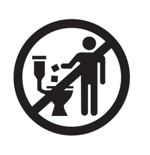Marine litter and microplastics
The United Nations Environmental Programme defines marine litter as, “any persistent, manufactured or processed solid material discarded, disposed of or abandoned in the marine and coastal environment.”
It can consist of items that have been:
- deliberately discarded into the sea or rivers or on beaches
- brought indirectly to the sea with rivers, sewage, storm water or winds
- or accidentally lost, including material lost at sea in bad weather
Sources are multiple and it leads to a wide range of environmental, economic, safety, health and cultural impacts. The slow rate of degradation of most items, mainly plastics, together with the continuously growing quantity disposed, is leading to a gradual increase in marine litter found at sea and on the shores.
A report of the Ellen MacArthur Foundation predicts that there will be an equal amount of microplastics in the oceans compared to fish by 2050. To better understand where plastics come from in the Marine Environment, consult the study and infographics done by Eunomia. Marine litter is a serious concern for the nonwovens industry. Beside partnering with associations such as PlasticsEurope to address problems and concerned raised , EDANA and its member companies, provide clear and correct information about marine litter and microplastics, and the industry’s actions to ensure that for instance wipes are disposed of correctly.
What are microplastics ?
According to ECHA (the European Chemical Agency) the working definition used for microplastics is:
Microplastics means a material consisting of solid polymercontaining particles, to which additives or other substances may have been added, and where ≥ 1% w/w of particles have (i) all dimensions 1nm ≤ x ≤ 5mm, or (ii), for fibres, a length of 3nm ≤ x ≤ 15mm and length to diameter ratio of >3 (date : 30 September 2019, the definition is subject to change)
As there is currently no international accepted definition, this working definition is subject to change.
Microplastics can be:
- An intentionally added ingredient within a product (e.g. micro-beads in cosmetics) or designed in a way that they could be released during their life cycle (e.g. agricultural use)
- Generated from the fragmentation or degradation of larger plastic waste or
- Created during the life cycle of a product (e.g. clothing) through wear and tear or emitted through accidental spills (e.g. polymer pellets)
For more information please consult the Eunomia report on Measuring the Impacts of Microplastics and UNEP report on Microplastic Pollution.

